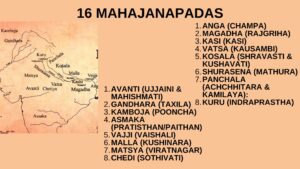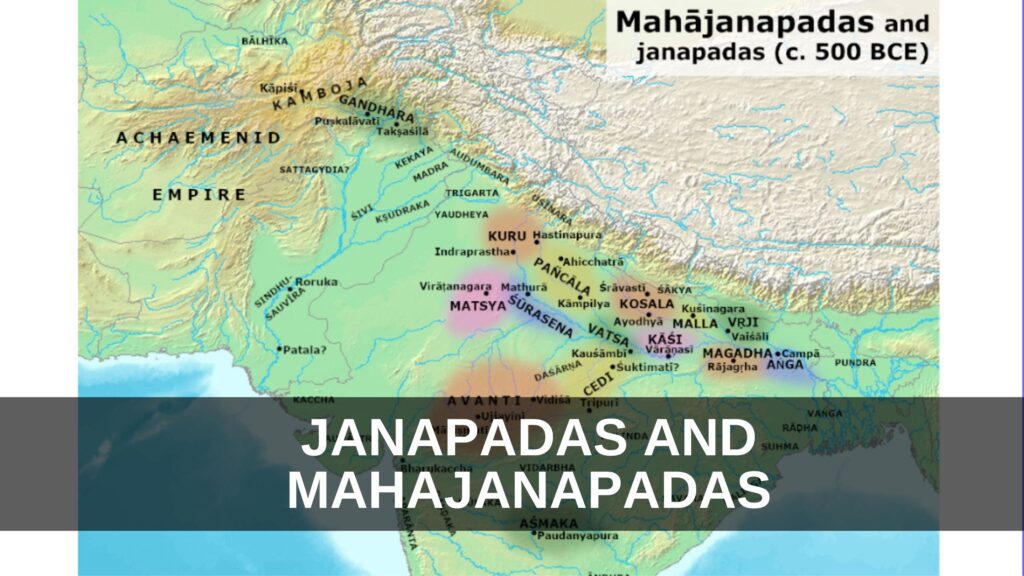The term ‘Janapada’ originates from the Sanskrit words ‘Jana’ (tribe) and ‘Pada’ (foot), signifying the land where a tribe settles. In early Vedic society, clans were predominantly pastoral, moving in search of better grazing lands. Over time, as people adopted agriculture, these settlements evolved into permanent territories known as Janapadas.
By the later Vedic period (1000 BCE – 600 BCE), these Janapadas transformed into organized states, some of which followed monarchial governance, while others embraced a republican structure.
The Transition to Mahajanapadas
From the 6th century BCE onwards, some Janapadas grew into larger political entities called Mahajanapadas. This transformation was driven by several socio-economic factors:
- Land replaced cattle as the primary source of wealth.
- Iron weapons and tools enhanced agricultural productivity and warfare.
- The surplus agricultural produce enabled taxation, supporting military and administrative needs.
- Towns emerged as trade and commerce flourished.
Read this blog also.. Indus Valley Civilization
The Sixteen Mahajanapadas
The Buddhist text Anguttara Nikaya lists sixteen prominent Mahajanapadas, spanning from modern-day Pakistan to Bengal and from the Himalayas to the Godavari River. These Mahajanapadas were conglomerates of numerous villages and towns. Below is a brief overview of some of these states:
- Anga (Champa): Eventually annexed by Magadha during Bimbisara’s reign.
- Magadha (Rajgriha): Became a center of Jainism and Buddhism.
- Kasi (Kasi): Initially powerful but later absorbed by Kosala.
- Vatsa (Kausambi): A trade hub along the Yamuna River.
- Kosala (Shravasti & Kushavati): Included the tribal territory of the Shakyas, the birthplace of Gautam Buddha.
- Shurasena (Mathura): Located on the Yamuna River, it was a key trading center.
- Panchala (Achchhitara & Kamilaya): Transitioned from monarchy to a republic.
- Kuru (Indraprastha): Known for the epic Mahabharata, governance evolved from monarchy to a republic.
- Matsya (Viratnagar): Located in modern Rajasthan.
- Chedi (Sothivati): Ruled by Shishupala, a figure in Mahabharata.
- Avanti (Ujjaini & Mahishmati): A significant Buddhist center.
- Gandhara (Taxila): An international trade hub, later captured by Persians.
- Kamboja (Pooncha): Famous for its superior horse breeds.
- Asmaka (Pratisthan/Paithan): The only Mahajanapada south of the Vindhya range.
- Vajji (Vaishali): A republican state with multiple clans, including the Lichchhavis and Videhans.
- Malla (Kushinara): A republic where Gautama Buddha attained Mahaparinirvana.

The Rise of Four Major Mahajanapadas
Among the sixteen, four Mahajanapadas—Magadha, Kosala, Avanti, and Vatsa—engaged in power struggles. Ultimately, Magadha emerged as the dominant force.
- Magadha: Expanded under Bimbisara and later Ashoka, controlling most of the Indian subcontinent.
- Kosala: Encompassed the Shakyas of Kapilvastu, associated with Buddha’s birthplace.
- Avanti: A crucial Buddhist region, later annexed by Magadha in the 4th century BCE.
- Vatsa: Flourished under Udayana, who made Buddhism the state religion.
Factors Behind Magadha’s Rise
Magadha’s dominance was fueled by several factors:
- Strategic Location: Rajgriha and later Pataliputra were geographically well-protected.
- Iron Deposits: Enabled the production of superior weapons.
- Agricultural Surplus: Fertile land in the Ganges plain facilitated taxation.
- Military Strength: The first state to use war elephants extensively.
- Urbanization: The rise of towns and coin-based trade boosted the economy.
Key Dynasties of Magadha
- Haryanka Dynasty (544 BCE – 412 BCE)
- Bimbisara (558 BCE – 491 BCE): Established a strong army and used marriage alliances.
- Ajatsatru (492 BCE – 460 BCE): Killed his father and convened the First Buddhist Council.
- Udayabhadra (460 BCE – 444 BCE): Shifted the capital to Pataliputra.
- Sisunaga Dynasty (413 BCE – 345 BCE)
- Sisunaga: Defeated Avanti and moved the capital to Vaishali.
- Kalasoka: Organized the Second Buddhist Council.
- Nanda Dynasty (345 BCE – 321 BCE)
- Mahapadmnanda: Expanded the empire and called himself Ekarat (sole sovereign).
- Dhanananda: Overthrown by Chandragupta Maurya with Kautilya’s help.
Economic Advancements
- Metal Technology: Widespread use of iron tools improved agriculture.
- Coinage: The earliest metal coins, mainly silver, were issued by merchant guilds and states.
- Taxation: Heavy taxation was imposed on Vaishyas and artisans, while Brahmins and Kshatriyas were exempt.
Political and Social Developments
- Republican States: Some Mahajanapadas, such as Vajji and Malla, followed a republican form of government.
- Legal System: The Dharmasutras established legal frameworks based on varna (social class).
- Decline of Assemblies: Monarchies diminished the role of popular assemblies like the Sabha and Samiti.
- Military Innovations: Magadha was the first to maintain a standing army and use elephants extensively in warfare.
Read about.. Harappan Civilization
Religious and Cultural Transformations
- Emergence of Buddhism and Jainism: These new faiths challenged Brahmanical dominance and emphasized ethical living.
- Position of Shudras: The lowest varna faced discrimination, and their plight remained largely unchanged.
- Urbanization and Material Culture: The Northern Black Polished Ware (NBPW) phase marked the second wave of Indian urbanization.
- Mathematics and Science: Texts like Sulba Sutras detailed early mathematical concepts, including geometry and measurements.
- Development of Writing: The re-emergence of writing facilitated trade, administration, and literature.


